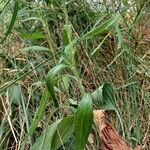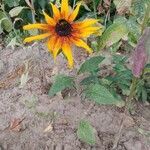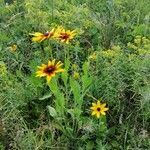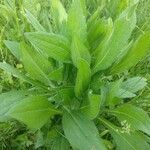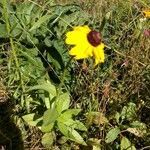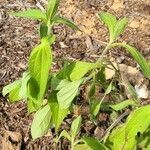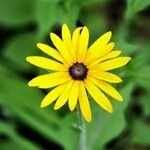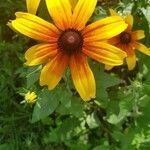Annuals, biennials, or perennials, to 100 cm (taprooted or roots fibrous). Stems hispid to hirsute (hairs spreading, 1+ mm). Leaves: blades elliptic, lanceolate, or ovate (not lobed), bases attenuate to cuneate, margins entire or serrate, apices acute, faces hispid to hirsute; basal petiolate, blades 8–30 × 0.5–7 cm; cauline petiolate or sessile, blades (sometimes pandurate) 3–20 × 0.4–4 cm. Heads borne singly or (2–5) in loose, corymbiform arrays. Phyllaries to 3 cm (faces hispid to hirsute). Receptacles hemispheric to ovoid; paleae 4–6 mm, apices acute, often attenuate, abaxial tips hirsute to hispid. Ray florets 8–16; laminae (usually uniformly yellow to yellow-orange or with a basal maroon splotch, sometimes mostly maroon) elliptic to oblong or oblanceolate, 15–45 × 5–10 mm, abaxially hispid to hirsute. Discs 12–22 × 10–20 mm. Disc florets 250–500+; corollas proximally yellowish green, distally brown-purple, 3–4.2 mm; style branches ca. 1.5 mm, apices subulate. Cypselae 1.5–2.7 mm; pappi 0.
Annuals, biennials, or perennials. Stems hispid to hirsute. Leaf blade elliptic, lanceolate, or ovate, hispid to hirsute, base attenuate to cuneate, margin entire or serrate, apex acute; basal leaves petiolate, blade 8-30 × 0.5-7 cm; cauline leaves petiolate or sessile, blade 3-20 × 0.4-4 cm. Capitula solitary or 2-5 in loose, corymbiform arrays; phyllaries to 3 cm; receptacle hemispheric to ovoid; paleae 4-6 mm, abaxially hirsute to hispid at apex, apex acute, often attenuate. Ray florets 8-16; corolla limb usually uniformly yellow to yellow-orange or with a basal maroon splotch, sometimes mostly maroon, elliptic to oblong or oblanceolate, 15-45 × 5-10 mm, abaxially hispid to hirsute. Disk 1.2-2.2 × 1-2 cm; disk florets numerous; corolla proximally yellowish green, distally brown-purple, 3-4.2 mm; style branches ca. 1.5 mm, apex subulate. Achenes 1.5-2.7 mm; pappus absent. Fl. Jun-Sep.
A herb. It can grow for one or more years. The leaves are entire. The lower leaves are oval and 8-30 cm long by 1-7 cm wide and the upper leaves are smaller. The ray flowers are yellow to orange and these are round dark purplish-brown disc flowers.
